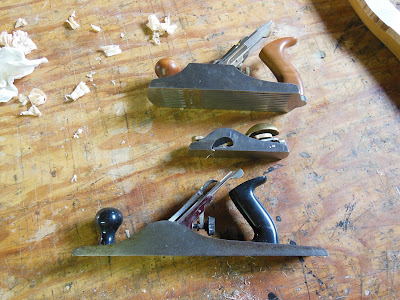Constructing a pattern of the long bridge by offsetting, using an acrylic disc. The diameter of the disc is not important, you make one offset, trim to the line, and then offset back. Below; cutting the pattern for the bass bridge, the material is 3mm 5 ply Baltic Birch. The bass bridge proper, was sawn from solid Beech, the long bridge is two vertical laminations of Beech. Neither piece is cut on the quarter, which I would normally prefer.
The bridge patterns laid out on the sound-board pattern, and aligned using the fixtures made earlier. The sound-board pattern is made of the same stuff as the bridge patterns. Notice that the holes for the bolts are very oversize, they are also not strictly concentric to the bolts. These will be made smaller with overlapping wooden washers, and aligned with the bolts in place.
Some Spruce (below) for sound-boards. Wide stuff on the bottom is around 12", 300mm. I will split these on the band saw, two, or three ways, to end up with 6 x 300mm. The grain widths here are very similar to those of the original. But let me say at the outset, this is not European white Spruce, it is Sitka. There will be those of you who will say that this is not correct, you are right. That the instrument will not sound as it did originally, you are also right, although this criticism can also be fairly leveled at a board made of white, or rather red Spruce. This was a difficult decision for me, but in the end I think it comes down to a matter of rightness in spirit rather than simple pedantry. There comes a time in restoring, or in this case copying, when being respectful of the original intentions of the maker, will involve the use of one's own taste and judgment.







Comments
Post a Comment